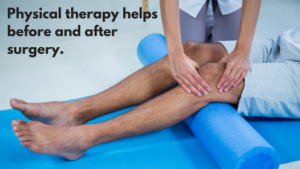How Orthopedics and Physical Therapy Work Together
Since October is National Physical Therapy Month, we wanted to discuss the important role physical therapy plays in the treatment and recovery of many of the injuries and conditions that we care for at OSMS. So we sat down with Andy Taber from one of our partners, Advanced Physical Therapy and Sports Medicine, to learn more about how physical therapy and orthopedics work together. Andy is a Doctor of Physical Therapy, Board Certified Orthopedic Clinical Specialist, and Board Certified Strength and Conditioning Specialist.
If you sustain an orthopedic injury like a torn meniscus or broken elbow, or you are diagnosed with a condition like arthritis, your orthopedic physician might recommend physical therapy as a starting point for treatment. Physical therapy can often be an effective nonsurgical treatment to relieve pain and restore function.
“Physical therapy can assist the body in the natural healing process,” Andy says. “Through physical therapy, we can address mechanical faults to help an injury heal. We also develop prevention strategies to reduce the risk of injury in other limbs that may try to overcompensate for the injured area during the healing process.”
For example: if a person is dealing with pain, stiffness, and inflammation from osteoarthritis, a physical therapist can help relieve symptoms by:
- Evaluating, diagnosing, and correcting gait and posture abnormalities that may increase the breakdown of a joint or cause injury to another area of the body.
- Improving strength, range of motion, and flexibility around an arthritic joint to reduce pain and improve overall function.
- Implementing joint protection strategies in an effort to conserve the remaining cartilage in a joint.
When an orthopedic surgery is needed to treat an injury or condition, physical therapy continues to play an important role.
Whether it’s repairing a torn ACL or replacing a hip joint, the ultimate success of a patient’s recovery after surgery is partially dependent on the condition of the patient going into surgery.
“Doing physical therapy before an orthopedic surgery can help improve flexibility and build strength around the injured or arthritic area,” Andy says. “And as range of motion and strength increases prior to surgery, the patient is likely to have an easier time recovering these aspects of mobility and function after surgery.”
Once an orthopedic surgery is performed, physical therapy helps the recovery process in several ways, including:
- Implementing interventions designed to reduce pain and improve comfort in the hopes of reducing the need for long-term use of pain medications.
- Helping patients understand how to properly use assistive devices such as crutches, walkers, and canes.
- Restoring range of motion and strength of the surgical area.
“Once the body gets through the initial post-operative inflammation, and the healing process is well established, physical therapy continues to help patients return to their previous level of function,” Andy says. “This is done through progressive, individualized retraining of motions, postures, and activities related to what a patient wants to get back to.”







